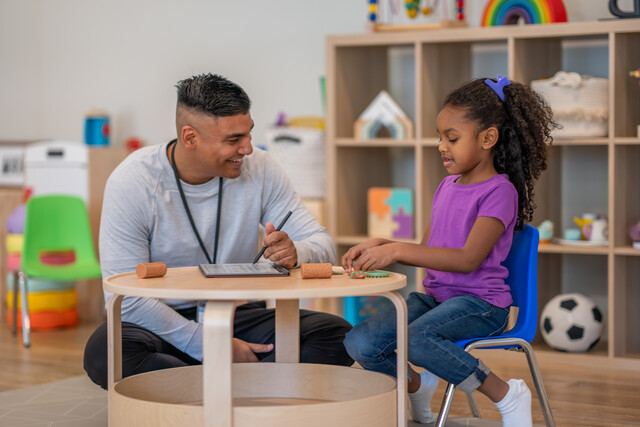Online Class: The Bullying Solution — Strategies for a Kinder Classroom

-
12Lessons
-
31Exams &
Assignments -
6Hours
average time -
0.6CEUs
Course Description
Bullying. The word alone sends a ripple of concern through parents, educators, and community leaders alike. It's a shadow that threatens to darken the most formative years of a child's life. But what if you could be the difference? What if you could equip yourself with the tools, strategies, and understanding to create a world where every child feels safe, valued, and empowered?
This is not just another course-it's a mission, a call to action, and a transformative journey for anyone who believes in the boundless potential of children and the sanctity of their emotional well-being.
Imagine a classroom where every child feels seen and heard. A playground where kindness flourishes, and no child is left feeling small or afraid. Picture yourself confidently addressing challenging behaviors, fostering resilience, and cultivating a culture of empathy that ripples far beyond the school walls. This course will show you how to turn that vision into reality.
You'll gain more than knowledge-you'll gain clarity. Together, we'll unpack the roots of bullying, exploring what drives these behaviors and how they manifest, even in the earliest years of education. You'll understand the profound impact bullying has on young hearts and minds and, more importantly, how to counter it with compassion, strength, and actionable strategies.
But this course isn't just about addressing the problem; it's about building a future. You'll discover the art of fostering self-esteem, teaching emotional intelligence, and empowering children to stand tall in the face of adversity. Learn how to guide shy, introverted students to find their voice and confidence. Uncover the keys to cultivating empathy and understanding, not just among children but within entire school communities.
This is where knowledge meets action. You'll be armed with proven techniques to tackle bullying head-on, from addressing incidents with tact and care to implementing preventative measures that create lasting change. Whether you're a parent navigating your child's challenges, a teacher striving to protect your students, or a community leader ready to inspire transformation, this course is your blueprint for success.
The stakes couldn't be higher, and the rewards couldn't be greater. A world without bullying isn't a distant dream-it's a choice we make, one conversation, one strategy, one action at a time. By enrolling in this course, you're taking the first, bold step toward that reality.
Don't let another day pass feeling unsure or helpless in the face of bullying. Join a community of changemakers dedicated to creating safe, supportive spaces for every child. Together, we can ensure no child is left to face this challenge alone.
Enroll today and become the advocate, ally, and architect of a brighter, bully-free future.
Course Lessons
Lesson 1. Understanding Bullying: A Modern Social Crisis
 Lesson 1 Video
Lesson 1 Video Review Practice Worksheet: Lesson-1-Activity-18202.pdf
Review Practice Worksheet: Lesson-1-Activity-18202.pdf Lesson discussions: Bullying
Lesson discussions: Bullying  Complete Assignment: An Introduction
Complete Assignment: An Introduction Assessment: Lesson 1 Exam
Assessment: Lesson 1 Exam Assessment: Lesson 1 Review Exam
Assessment: Lesson 1 Review Exam
Lesson 2. Resilience Rising: Overcoming Bullying Together
 Lesson 2 Video
Lesson 2 Video Review Practice Worksheet: Lesson-2-HomeWork-18203.pdf
Review Practice Worksheet: Lesson-2-HomeWork-18203.pdf Assessment: Lesson 2 Exam
Assessment: Lesson 2 Exam Assessment: Lesson 2 Review Exam
Assessment: Lesson 2 Review Exam
Lesson 3. Peeling Back the Layers of Bullying: Understanding and Addressing the Roots of Aggressive Behavior
 Lesson 3 Video
Lesson 3 Video Review Practice Worksheet: Lesson-3-HomeWork-18205.pdf
Review Practice Worksheet: Lesson-3-HomeWork-18205.pdf Assessment: Lesson 3 Exam
Assessment: Lesson 3 Exam Assessment: Lesson 3 Review Exam
Assessment: Lesson 3 Review Exam
Lesson 4. The Impact and Interventions of Bullying
 Lesson 4 Video
Lesson 4 Video Review Practice Worksheet: Lesson-4-StudyGuide-18207.pdf
Review Practice Worksheet: Lesson-4-StudyGuide-18207.pdf Assessment: Lesson 4 Exam
Assessment: Lesson 4 Exam Assessment: Lesson 4 Review Exam
Assessment: Lesson 4 Review Exam
Lesson 5. Cultivating Compassion: Nurturing Young Hearts Towards Kindness
 Lesson 5 Video
Lesson 5 Video Review Practice Worksheet: Lesson-5-Downloadable-18208.pdf
Review Practice Worksheet: Lesson-5-Downloadable-18208.pdf Lesson discussions: Teaching Kindness
Lesson discussions: Teaching Kindness Complete: Lesson 5 Activity
Complete: Lesson 5 Activity Assessment: Lesson 5 Exam
Assessment: Lesson 5 Exam Assessment: Lesson 5 Review Exam
Assessment: Lesson 5 Review Exam
Lesson 6. Navigating Bullying: Empowering Children and Adults Alike
 Lesson 6 Video
Lesson 6 Video Review Practice Worksheet: Lesson-6-Downloadable-18210.pdf
Review Practice Worksheet: Lesson-6-Downloadable-18210.pdf Complete: Lesson 6 Activity
Complete: Lesson 6 Activity Assessment: Lesson 6 Exam
Assessment: Lesson 6 Exam Assessment: Lesson 6 Review Exam
Assessment: Lesson 6 Review Exam
Lesson 7. The Art of Communication: A Key to Ending Bullying
 Lesson 7 Video
Lesson 7 Video Review Practice Worksheet: Lesson-7-HomeWork-18212.pdf
Review Practice Worksheet: Lesson-7-HomeWork-18212.pdf Assessment: Lesson 7 Exam
Assessment: Lesson 7 Exam Assessment: Lesson 7 Review Exam
Assessment: Lesson 7 Review Exam
Lesson 8. The Importance of Confidence in Combating Bullying
 Lesson 8 Video
Lesson 8 Video Review Practice Worksheet: Lesson-8-WorkSheet-18213.pdf
Review Practice Worksheet: Lesson-8-WorkSheet-18213.pdf Complete: Lesson 8 Activity
Complete: Lesson 8 Activity Assessment: Lesson 8 Exam
Assessment: Lesson 8 Exam Assessment: Lesson 8 Review Exam
Assessment: Lesson 8 Review Exam
Lesson 9. Emotions Unpacked
 Lesson 9 Video
Lesson 9 Video Review Practice Worksheet: Lesson-9-StudyGuide-18215.pdf
Review Practice Worksheet: Lesson-9-StudyGuide-18215.pdf Complete: Lesson 9 Activity
Complete: Lesson 9 Activity Assessment: Lesson 9 Exam
Assessment: Lesson 9 Exam Assessment: Lesson 9 Review Exam
Assessment: Lesson 9 Review Exam
Lesson 10. Helping Shy Children Thrive: A Comprehensive Guide
 Lesson 10 Video
Lesson 10 Video Review Practice Worksheet: Lesson-10-StudyGuide-18217.pdf
Review Practice Worksheet: Lesson-10-StudyGuide-18217.pdf Assessment: Lesson 10 Exam
Assessment: Lesson 10 Exam Assessment: Lesson 10 Review Exam
Assessment: Lesson 10 Review Exam
Lesson 11. Recognizing and Addressing Child Bullying: A Parent's Guide
 Lesson 11 Video
Lesson 11 Video Review Practice Worksheet: Lesson-11-WorkSheet-18218.pdf
Review Practice Worksheet: Lesson-11-WorkSheet-18218.pdf Complete: Lesson 11 Activity
Complete: Lesson 11 Activity Assessment: Lesson 11 Exam
Assessment: Lesson 11 Exam Assessment: Lesson 11 Review Exam
Assessment: Lesson 11 Review Exam
Lesson 12. The Power of Community Collaboration in Preventing Bullying
 Lesson 12 Video
Lesson 12 Video Review Practice Worksheet: Lesson-12-Activity-18220.pdf
Review Practice Worksheet: Lesson-12-Activity-18220.pdf Lesson discussions: Elementary School Bullying; Program Evaluation Follow-up Survey (End of Course); Course Comments
Lesson discussions: Elementary School Bullying; Program Evaluation Follow-up Survey (End of Course); Course Comments Complete: Lesson 12 Activity
Complete: Lesson 12 Activity Assessment: The Final Exam
Assessment: The Final Exam Assessment: Lesson 12 Review Exam
Assessment: Lesson 12 Review Exam
Learning Outcomes
- Define and differentiate between the four main types of bullying: physical, verbal, social, and cyber, using real-world examples.
- Identify at least three strategies to effectively address and prevent bullying in school and community settings, with an emphasis on inclusivity and bystander empowerment.
- Describe the psychological effects of bullying on children's self-esteem and mental health by identifying at least three specific impacts with examples from real-life scenarios.
- Recognize and analyze the warning signs of bullying in children by listing at least four indicators including changes in behavior and academic performance.
- Demonstrate the ability to propose inclusive strategies that promote empathy and reduce bullying within educational and community settings.
- Recognize and describe the underlying psychological and societal factors contributing to bullying behavior.
- Identify and implement effective strategies for bullying prevention, including empathy-building, empowerment, and community engagement.
- Recognize and describe the psychological impact of bullying on victims, bystanders, and bullies.
- Define and illustrate examples of empathy, compassion, tolerance, and stereotype dismantling in real-world scenarios involving children.
- Recognize and demonstrate acts of kindness in school projects by organizing inclusive activities that embody empathy and acceptance.
- Demonstrate effective communication strategies, like assertive 'I' statements, in 2 out of 3 role-play scenarios involving bullying encounters.
- Define the psychological motivations behind bullying, including insecurity and a need for control, with 90% accuracy based on given scenarios.
- Define and categorize the various forms of bullying, including physical, verbal, social, and cyberbullying, by providing specific examples for each type.
- Demonstrate mastery of lesson content at levels of 70% or higher.
Additional Course Information

- Document Your Lifelong Learning Achievements
- Earn an Official Certificate Documenting Course Hours and CEUs
- Verify Your Certificate with a Unique Serial Number Online
- View and Share Your Certificate Online or Download/Print as PDF
- Display Your Certificate on Your Resume and Promote Your Achievements Using Social Media

Student Testimonials
- "Thank you. I enjoyed the information on role plays." -- Monica H.
- "I feel more knowledgeable after taking this course!" -- Elisabeth R.
- "Material was very well organized and helpful." -- Janice M.
- "Excellent instructor; knowledgeable, helpful, on time in providing feedback." -- Mohammad H.
Related Courses
-
 5 hours
0.5 CEUs
Basic Parenting Skills
+ More Info
5 hours
0.5 CEUs
Basic Parenting Skills
+ More Info
-
 7 hours
0.7 CEUs
Attention Deficit Disorders: ADD and ADHD
+ More Info
7 hours
0.7 CEUs
Attention Deficit Disorders: ADD and ADHD
+ More Info
-
 2 hours
0.2 CEUs
Professional Babysitting Skills
+ More Info
2 hours
0.2 CEUs
Professional Babysitting Skills
+ More Info
-
 5 hours
0.5 CEUs
Child Safety for Parents
+ More Info
5 hours
0.5 CEUs
Child Safety for Parents
+ More Info
-
 5 hours
0.5 CEUs
Children's Birthday Parties 101
+ More Info
5 hours
0.5 CEUs
Children's Birthday Parties 101
+ More Info
-
 8 hours
0.8 CEUs
Behavior Management 101
+ More Info
8 hours
0.8 CEUs
Behavior Management 101
+ More Info
-
 7 hours
0.7 CEUs
Understanding Concussions
+ More Info
7 hours
0.7 CEUs
Understanding Concussions
+ More Info
-
 3 hours
0.3 CEUs
Empowerment for Single Parents
+ More Info
3 hours
0.3 CEUs
Empowerment for Single Parents
+ More Info
-
 5 hours
0.5 CEUs
The Science and Art of Reading Development
+ More Info
5 hours
0.5 CEUs
The Science and Art of Reading Development
+ More Info
-
 5 hours
0.5 CEUs
Positive Parenting Techniques
+ More Info
5 hours
0.5 CEUs
Positive Parenting Techniques
+ More Info
-
 10 hours
1.0 CEUs
Understanding Addictions
+ More Info
10 hours
1.0 CEUs
Understanding Addictions
+ More Info
-
 7 hours
0.7 CEUs
Solving Classroom Discipline Problems
+ More Info
7 hours
0.7 CEUs
Solving Classroom Discipline Problems
+ More Info
-
 5 hours
0.5 CEUs
Home Safety
+ More Info
5 hours
0.5 CEUs
Home Safety
+ More Info





